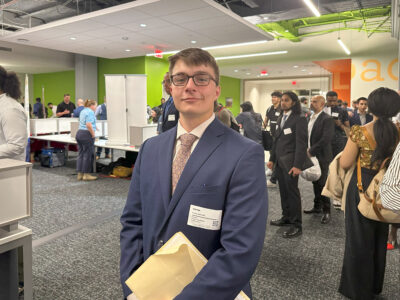- Software developers contribute significantly to regional economies, and demand is expected to outpace population growth — but there’s a geographic mismatch, with some regions producing many more computer science grads than jobs available, and vice versa.
- Alternative education programs are key to filling these local tech talent gaps, with coding bootcamps and apprenticeships emerging as popular solutions alongside traditional higher education.
- Diversifying the pipeline isn’t just about morality or equity; ensuring underrepresented groups discover and get into tech careers can help solve regional talent disparities.
Emmanuel Offiong was supposed to be a doctor.
“I really didn’t do great with the sight of blood,” said Offiong, the son of ambitious Nigerian immigrants. “But what I did love was taking big problems, dissecting them into smaller problems and solving them. That’s what drew me to software engineering.”
Now Offiong is Capital One’s chief technology officer of small business banking. He’s also the executive sponsor of the corporation’s Coders program, which boasts its execs have mentored 22,000 students over the last 10 years.
Corporate do-good programs are widespread. Some put white-collar executives into matching t-shirts to join annual park cleanups. Others, like Coders, aim to put employee’s professional skills to work addressing key economic issues.
And who will prepare future STEM-curious workers remains one of the big economic questions of our future.
“Our goal is to get middle schoolers excited about solving problems through technology,” Offiong told me. “We hope they’ll go on to study computer science in college and, hopefully, come and join Capital One to solve some really big problems.”
Software developers as bellwether: Building the pipeline to boost local economies
Despite the rocky last year of tech employment, the US Bureau of Labor Statistics still predicts demand for software developers will far outpace population growth over the next decade. No, artificial intelligence will not replace software developers — just change the job.
Software is certainly not the only technical role in demand in vibrant economies. Research science, hard engineering and a slew of health fields are all important growth jobs.
But software developers are a helpful representation of dynamism: It’s one, clear, specific job title that isn’t only hired by software makers but also in robotics and retail, financial services and telecommunications. They’re highly productive roles, developing tools once that can be used many times over. One group estimates they contribute to as many as 4.4 other jobs in a local economy (from the barista to the carpenter to the surgeon).
US regions with the highest concentration of software developers tend to also be among the country’s most economically vibrant places: Silicon Valley, Seattle, Washington DC and others. It figures that most advanced economic development strategies pair entrepreneurial engagement with workforce development that has a tech talent component.
The United States has a geographic mismatch between what regions have more computer science graduates than tech jobs, and vice versa.
Big regions with dynamic economies like New York, Chicago and Washington DC produce lots of computer science graduates. Big college cities like Boston, Atlanta and Philadelphia do too. Pittsburgh and Baltimore do OK. In contrast, Silicon Valley, Seattle and Austin have far more tech openings than they graduate locally and must attract from other regions.
Fast-growing regions with little homegrown tech talent to speak of — like Nashville, Tulsa and parts of Florida, Texas and the US southwest — put considerable effort into talent attraction. If ya don’t make tech talent, then you better import ‘em.
Two other policy solutions are popular.
One is to look at alternative programs beyond traditional higher education. No surprise that the modern coding bootcamp — where reasonably clever people are pumped with practical tech skills over a period of weeks, at the expense of underlying theory — was developed in move-fast and educate-few Silicon Valley. Apprenticeship programs like one at Accenture are also popping up.
Focused vocational and certificate programs are popular and growing fast. In 2015, fewer than 20,000 people graduated from American coding bootcamps. One industry analyst suggests the total could top 350,000 next year. In contrast, just 100,000 students graduated with computer science degrees last year, though the number grows when related fields are included.
Experimenting with more accommodating tools to help people transition into high-growth parts of the economy at any stage of their career is good. It will take time to sort itself out.
The second big strategy is to make the tech pipeline look more representative of the population as a whole.
What kind of programs get the best results for the widest group of people?
Tech talent programs commonly target people from populations underrepresented in the field, which typically includes women, Black and Hispanic residents and sometimes low wealth and differently abled people. As documented in a special report from Technical.ly last year, this kind of workforce programming extends beyond the morality of social justice.
For talent hungry regions, a pipeline that isn’t representative of regional demographics is a signal that there may be opportunities to boost employment.
The percentage of computer science graduates who were women peaked at 37% — in 1984.
Here, the signals are famously disappointing. The percentage of computer science graduates who were women peaked at 37% — in 1984. Their share mostly declined for the next 20 years, coinciding with big economic changes. In 1983, the U.S. Commission on Human Rights held a hearing in San Jose to review disappointing representation in tech jobs — just 5% were Black or Hispanic. Some 40 years later, as reported in another special Technical.ly report, the share at big tech companies remained essentially unchanged.
Attention shifted after the Great Recession, which shook American attitudes toward the economy. Among coveted jobs, out went finance, and in came tech, which ballooned during the 2010s.
A slew of programs turned on to shift the tech talent pipeline. Modest, if inconsistent, progress on tech representation has followed. In each of the 10 years between 2012 and 2022, according to the National Center for Education Statistics, the share of computer science graduates who were women has climbed.
Using federal pandemic relief funds, leaders in Arlington, Virginia, announced in 2022 their own pilot software training program — and the satellite city has quietly become a software hub, with the help of securing Amazon HQ2. Fueled by Build Back Better funds, the New Economy Collaborative in western Pennsylvania is growing a handful of workforce programs, including ones tied to software and automation.
Other nonprofits have stood up training programs, though the pandemic has been an erratic period. Many experienced single year surges in income, which may have contributed to the collapse of Byte Back in Washington DC and Women Who Code.
In contrast, corporate social responsibility programs like Capital One’s Coders program have proved more stable, if modest. The Capital One team won’t detail the specific financial investment they’ve committed to the program and any corporate do-good program has a marketing veneer, but Offiong says they’ve contributed more than 130,000 staff volunteer hours over the program’s decade.
“We’re using Coders as a way to build more brand awareness as we strive to be a tech company that offers financial products,” Offiong said. “But at the end of the day, it’s also about creating a pipeline for future talent.”
The program partners with public schools and youth-serving nonprofits to introduce middle school students to computer science.
“Be intentional about where you invest your energies. Not every school is equipped to help you help the students, so choose your partners carefully.”
Emmanuel Offiong, Capital One
Last year, the program won plaudits from the Governor’s office in Virginia, where the company is headquartered and has worked for years inside Richmond Public Schools. There Offiong remembers a young student who developed advanced software on her own time. “It really blew our minds,” he said. “To see someone at that age taking such initiative and producing work of that caliber is exactly why we do this.”
Offiong has a personal connection to the program’s purpose. Born in Washington DC, but raised in Nigeria, he returned to the US for college, where his talent for mathematics and computer science quickly became evident.
“I just remember being in one of my statistics classes and doing much better than my peers because it came so naturally to me,” he said. Exposure gives kids a chance to find their own spark.
Not all groups are ready to partner. Offiong added one lesson from 10 years of the program: “Be intentional about where you invest your energies. Not every school is equipped to help you help the students, so choose your partners carefully.”
That means there are still gaps in who gets exposed to fast-growing careers. A few high-performing public and private schools have coding in their curriculum. Nonprofits, alternative programs and corporate efforts help too.
“There’s been so many cases,” Offiong said, “of middle school parents actually coming to us and saying, ‘Because of you, my child now has an interest in studying computer science at a higher level.”
Before you go...
Please consider supporting Technical.ly to keep our independent journalism strong. Unlike most business-focused media outlets, we don’t have a paywall. Instead, we count on your personal and organizational support.
Join our growing Slack community
Join 5,000 tech professionals and entrepreneurs in our community Slack today!






